hankyoreh
Links to other country sites 다른 나라 사이트 링크
Sewol ferry emerges in its entirety after nearly three years under the sea
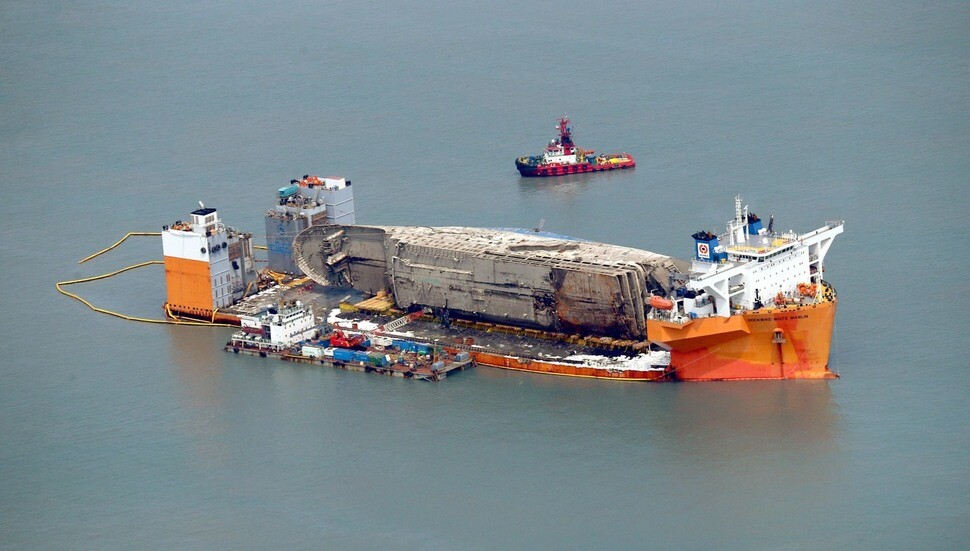
The Sewol ferry has become visible in its entirety for the first time in 1,075 days. Even its left side, which had previously been out of view, has been partially revealed.
The blue hull first came into view at 11:20 am on Mar. 26 on board the Jeonnam 201, a South Jeolla Province fishery inspection boat departing Swimi Harbor in South Jeolla’s Jindo County. The Sewol had been mounted on a semi-submersible vessel. Stains of white and black were visible on its blue bottom, testifying to the passage of nearly three years underwater. Even through the passage from neap to mean tide, the sea remained calm.
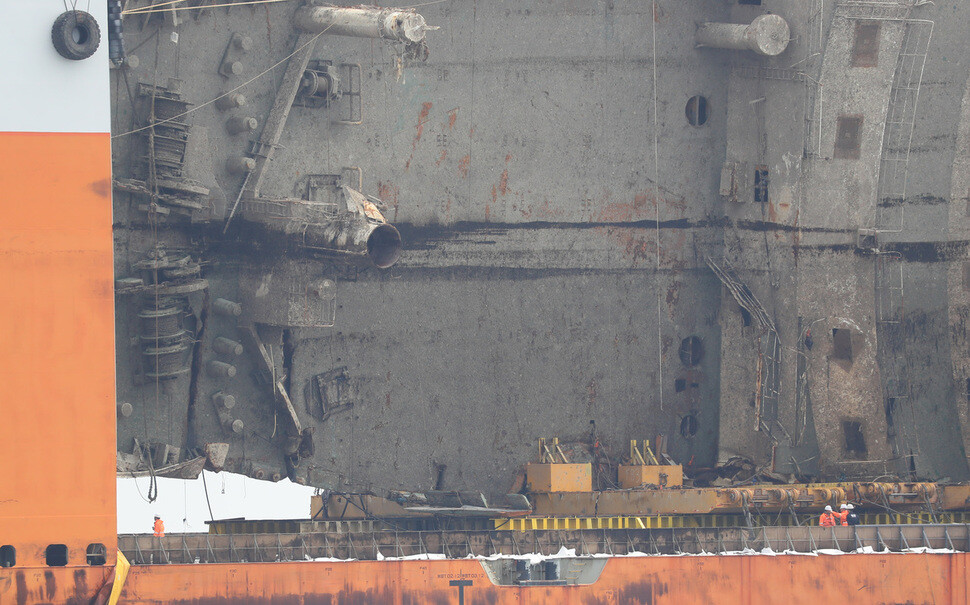
Two long cracks could immediately be seen on the Sewol’s left bow deck. Measuring 6.1 and 7.1 meters, the damage appeared in two parts of the deck as steel wire dug into the hull during a bow raising attempt last June. During the placement of a lifting beam, strong swells two meters high caused a sharp increase in the load due to up-and-down motion, causing the wire to cut into the hull like a saw. Blackened scratches could also be seen in the middle of the ship’s bottom. Crew members on the fishery inspection boat said these were most likely scratches from the salvage effort rather than the result of being under the sea for so long.
Red rust stains were also visible all over the deck. The left side showed an indentation toward the cabins, perhaps due to the shock of the sinking. A white metal fence put in place to prevent passengers from falling into the sea had also crumbled.
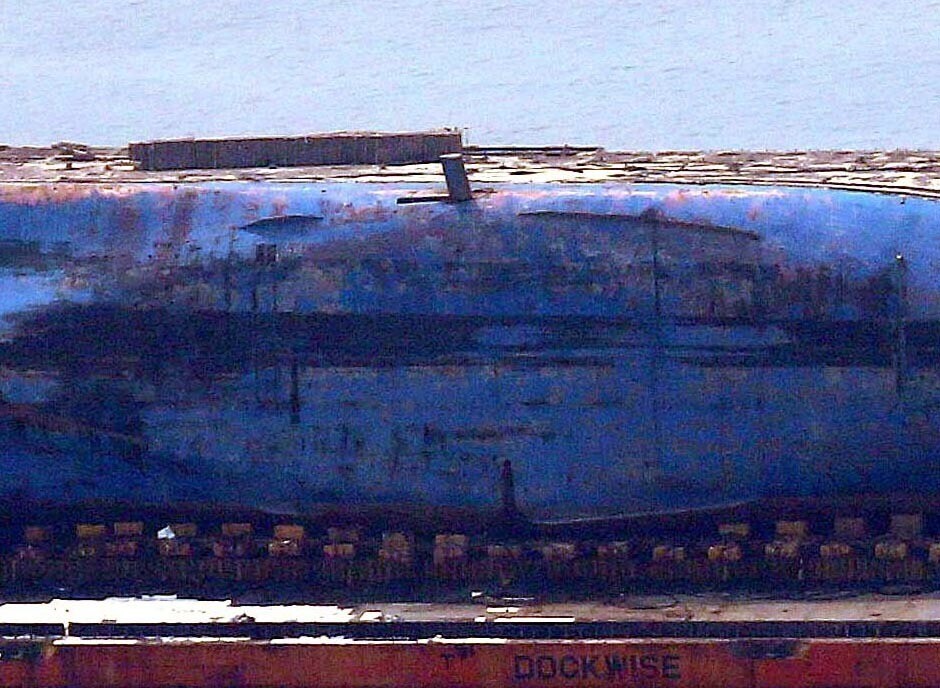
The Sewol’s left stern was in similarly grim condition. With no ramp present, a car and a small excavator hung there precariously. After belatedly discovering on the second day of the raising that the ramp was open, the Ministry of Oceans and Fisheries rushed divers in to detach it. With an unclear grasp on even how long the 7.9- by 11-meter ramp had been open, the fear was that passenger remains and personal effects might be lost.
“There was a container blocking the ramp entrance, so it doesn’t appear anything was lost,” said Lee Cheol-jo, head of the Ministry’s Sewol raising team.
But an actual examination of the ramp showed no container, with only the car and excavator wedged inside - raising questions about whether cargo had already been lost. The Ministry explained that the as yet unrecovered victims and passengers’ personal effects had not been lost because they were located in the cabins rather than in the cargo compartment.
The side of the Sewol’s hull, which has many portholes, could not be seen. But loss prevention netting was on the portholes for the deck wheelhouse and elsewhere. While the netting was present on most windows, it was absent from others, though it was unclear whether it had not been installed or had fallen away.
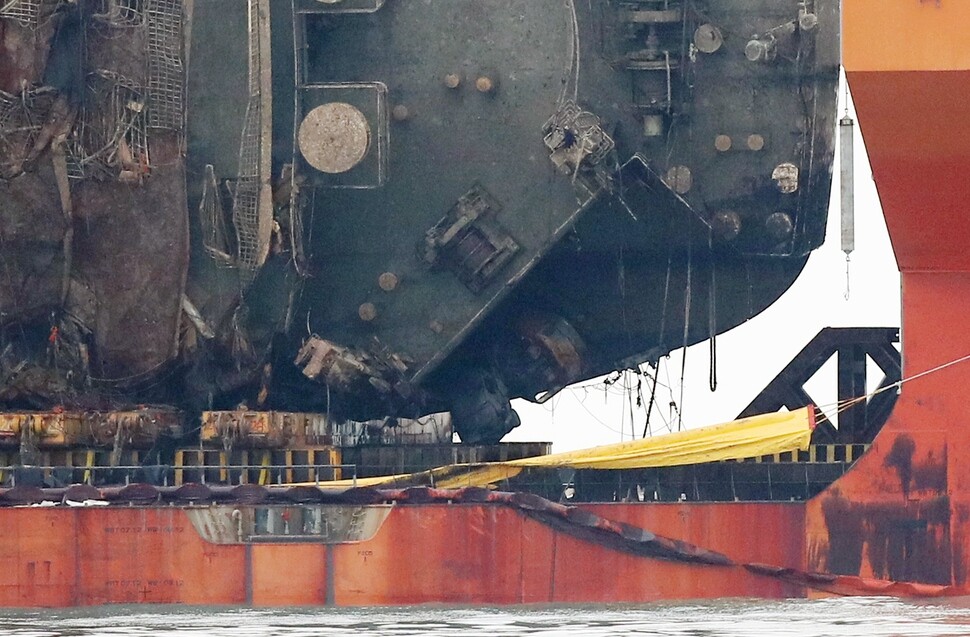
On the vessel’s bottom, the rudder was found to be turned five to ten degrees to the right. This condition of the rudder indicates that the ferry was making a five- to ten-degree right turn. Prosecutors previously concluded that the helmsman mistakenly set the steering gear to a large 35-degree turn at the time of the accident, causing the Sewol to turn sharply to the right. Due to its compromised stability, the ferry listed to the left and capsized, they explained. But if the rudder was in its current state at the time of the accident, it appears unlikely that the vessel turned sharply as a result.
“If it went up to five to ten degrees starboard, that would have been the right direction,” said Korea Maritime and Ocean University professor Kim Se-won.
“The rudder operates by way of a gear. As long as [the gear] is undamaged, it should be as it was,” Kim added.
“It doesn’t appear [the vessel] was steered at a steep angle,” he said.
Some suggested it would be premature to conjecture about the situation at the time of the accident from the Sewol’s condition as currently visible.
“There are lot of circumstances at play,” said Mokpo National Maritime University professor Yang Won.
“It’s possible that the hydraulic system adjusting the rudder could not hold on to it [in its condition at the time of the sinking] due to oil leaking or other damage from being underwater for three years,” Yang said.
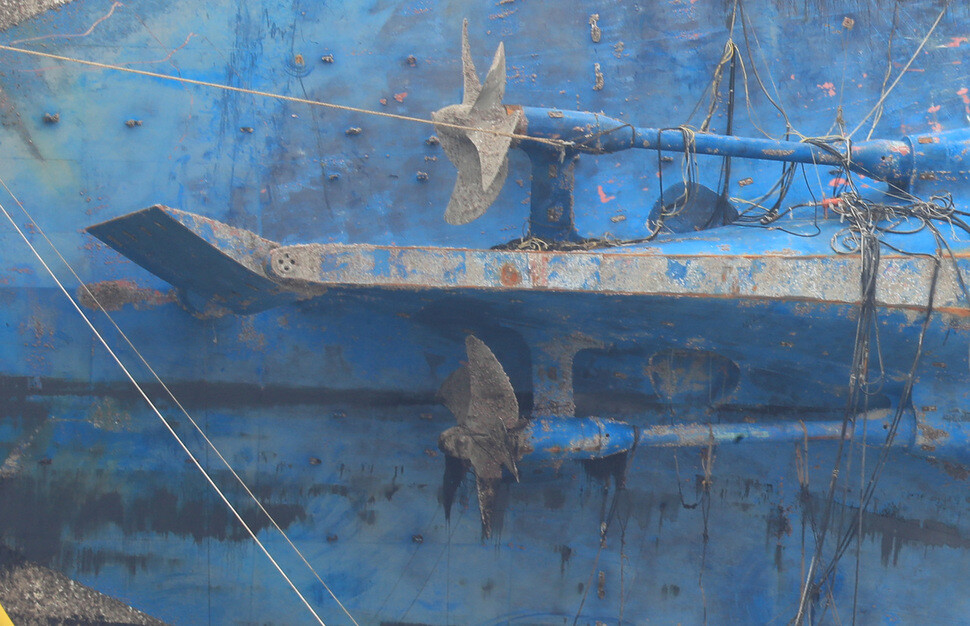
“It could also have reversed from striking the ocean floor. Even if it had been turned 30 degrees to right at the time of the accident, [the helmsman] could have turned it back five to seven degrees in a panic from the listing. We’d have to do a close examination to be sure.”
The Sewol is currently undergoing water and oil removal. Surface cleaner vessels around it blew heavily at the discharged oil to disperse it over the water to evaporate naturally. To the naked eye, no seawater could be observed flowing from the hull, but black bands of oil were visible on the water around the ferry. Fishery inspection boat crew members said the oil was “all over the place.” The semi-submersible vessel carrying the Sewol is scheduled to depart for Mokpo as early as Mar. 28.
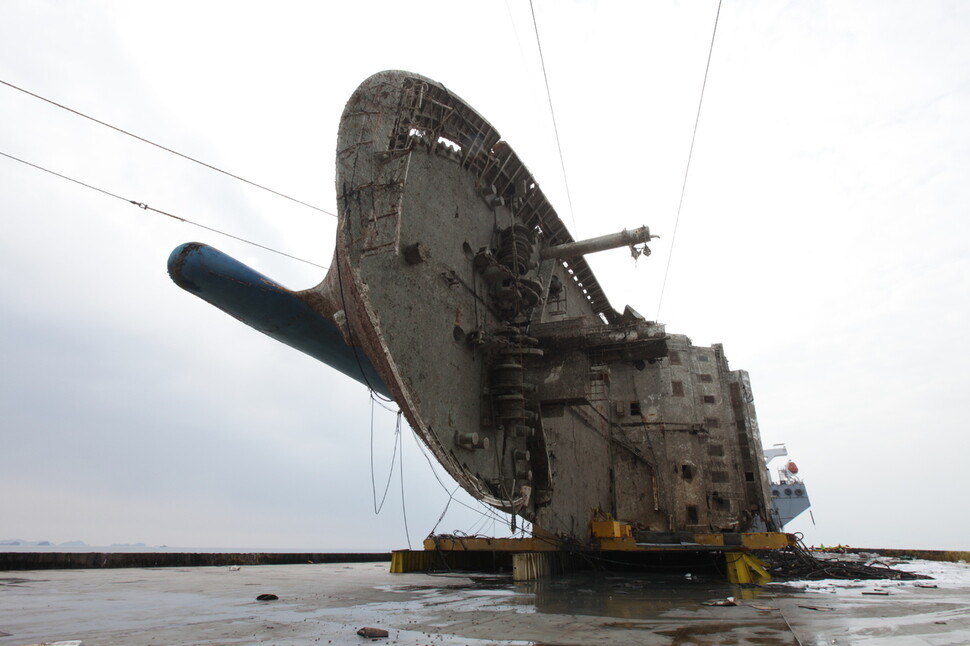
By Kim So-youn and Park Su-ji, staff reporters
Please direct questions or comments to [english@hani.co.kr]

Editorial・opinion
![[Guest essay] The real reason Korea’s new right wants to dub Rhee a founding father [Guest essay] The real reason Korea’s new right wants to dub Rhee a founding father](https://flexible.img.hani.co.kr/flexible/normal/500/300/imgdb/original/2024/0423/8317138574257878.jpg) [Guest essay] The real reason Korea’s new right wants to dub Rhee a founding father
[Guest essay] The real reason Korea’s new right wants to dub Rhee a founding father![[Column] ‘Choson’: Is it time we start referring to N. Korea in its own terms? [Column] ‘Choson’: Is it time we start referring to N. Korea in its own terms?](https://flexible.img.hani.co.kr/flexible/normal/500/300/imgdb/original/2024/0423/3617138579390322.jpg) [Column] ‘Choson’: Is it time we start referring to N. Korea in its own terms?
[Column] ‘Choson’: Is it time we start referring to N. Korea in its own terms?- [Editorial] Japan’s rewriting of history with Korea has gone too far
- [Column] The president’s questionable capacity for dialogue
- [Column] Are chaebol firms just pizza pies for families to divvy up as they please?
- [Column] Has Korea, too, crossed the Rubicon on China?
- [Correspondent’s column] In Japan’s alliance with US, echoes of its past alliances with UK
- [Editorial] Does Yoon think the Korean public is wrong?
- [Editorial] As it bolsters its alliance with US, Japan must be accountable for past
- [Guest essay] Amending the Constitution is Yoon’s key to leaving office in public’s good graces
Most viewed articles
- 1[Column] ‘Choson’: Is it time we start referring to N. Korea in its own terms?
- 2Senior doctors cut hours, prepare to resign as government refuses to scrap medical reform plan
- 3[Guest essay] The real reason Korea’s new right wants to dub Rhee a founding father
- 4Why Korea shouldn’t welcome Japan’s newly beefed up defense cooperation with US
- 5[Column] The clock is ticking for Korea’s first lady
- 6Opposition calls Yoon’s chief of staff appointment a ‘slap in the face’
- 7New AI-based translation tools make their way into everyday life in Korea
- 8Terry Anderson, AP reporter who informed world of massacre in Gwangju, dies at 76
- 9Korean government’s compromise plan for medical reform swiftly rejected by doctors
- 10[Editorial] Japan’s rewriting of history with Korea has gone too far